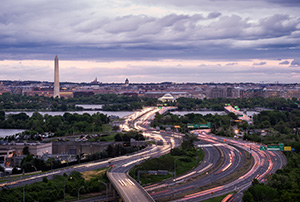Menu
Limitations on Lobbying Activities: Everything that 501(c)(3) Organizations Need to Know
by Susan C. Hamsher, Esq.
Counsel
Tenenbaum Law Group PLLC
August 24, 2022
Nonprofit organizations that qualify for federal income tax exemption under Section 501(c)(3) of the Internal Revenue Code (the “Code”) – except for private foundations – are permitted to lobby within certain limits. This document summarizes what limits apply to the lobbying activities of a 501(c)(3) organization that is a public charity and not a private foundation (a “Charity”) and describes what activities are considered lobbying under each of the different tests.
Lobbying Activity Limits
There are two different tests the IRS uses to determine how much lobbying a Charity may engage in before incurring penalties. Each of these tests uses a different definition of “lobbying.” The two different tests are summarized as follows:
- 501(h) Expenditure Test: Charities that choose to make the so-called “lobbying election” under Section 501(h) of the Code (generally referred to as “501(h) electors”) are subject to the definition of lobbying in Section 4911 of the Code and what is called the “501(h) expenditure test” to determine how much lobbying they can engage in. A charity may make the 501(h) election at any time by filing the simple one-page IRS Form 5768 with the IRS. The election is retroactive to the beginning of the tax year in which the IRS Form 5768 is filed. Under the 501(h) Expenditure Test, the amount of lobbying a Charity may engage in is equal to a proportion of its “exempt purpose expenditures” – the amount the Charity spends on activities in furtherance of its tax-exempt purposes. Under Section 4911(c)(2) of the Code, the equation to determine a Charity’s Total Lobbying Expenditures Limit is:
Total Lobbying Expenditures Limit = 20% of the first $500,000 of exempt purpose expenditures +
15% of the second $500,000 of exempt purpose expenditures +
10% of the third $500,000 of exempt purpose expenditures +
5% of the remainder of exempt purpose expenditures.
However, in no case may a Charity’s lobbying expenditures be greater than $1 million annually. In addition to this $1 million lobbying cap, a Charity may not spend more than 25% of its permitted lobbying total on Grassroots Lobbying (defined below).
- No Substantial Part Test: Charities that do not make the 501(h) election (generally referred to as “non-electors”) are subject to what is called the “no substantial part” (“NSP”) test to determine how much lobbying they can engage in. This is the default test for Charities under which no substantial part of a Charity’s activities may be to influence legislation. The IRS uses a “facts and circumstances test” to determine how much lobbying is considered substantial. The IRS has provided very little guidance on how much lobbying is substantial, however, in Seasongood v. Commissioner, a federal court in 1955 determined that 5% of an organization’s “time and effort” amounted to an insubstantial part of its overall activities. For this reason, a general rule of thumb for non-electors is to dedicate no more than 3-5% of their overall activities to lobbying. Note, however, that lobbying activities under the NSP test include more than just the lobbying performed by a Charity’s staff. Charities must also track and report lobbying activities performed by volunteers on the Charity’s behalf. The penalty for engaging in lobbying activities considered substantial is the loss of a Charity’s federal tax-exempt status.
Most Charities that lobby choose to make the 501(h) election to have more certainty and predictability with regard to its limit on lobbying and what activities are considered lobbying. In addition, 501(h) electors are less likely to lose their federal tax exemption for excessive lobbying as they are subject to penalty taxes rather than the immediate loss of tax exemption under the NSP test. Lastly, in practice, making the 501(h) election allows many Charities to have higher lobbying limits than they otherwise would under the NSP test. However, this only holds true for smaller Charities. Larger Charities – generally, those with at least $17 million of exempt purposes expenditures per year – may be able to engage in more lobbying under the NSP test.
Defining Lobbying Activities for 501(h) Electors
A Charity’s total "lobbying expenditures" is equal to all amounts paid or incurred for, or in connection with, direct and grassroots lobbying communications – including amounts paid or incurred as current or deferred compensation for employees’ services attributable to lobbying, as well as the allocable share of overhead expenses attributable to lobbying. Direct and Grassroots Lobbying are defined as:
- Direct Lobbying: A communication that expresses a view about specific legislation made to a legislator.
- Grassroots Lobbying: A communication that expresses a view about specific legislation made to the general public that contains a call to action.
Each of the italicized terms are defined as follows:
Communication: sending information in writing, orally, electronically, or in person.
Expresses a View: takes a position, either for or against.
Specific Legislation: Specific legislation is action by a legislature and may include any of the following:
- A bill (e.g., H.R. 8, S. 3062)
- Proposed legislation (e.g., model bills)
- Draft amendments
- Specific legislative policy proposals (see definition below)
- Congressional Resolutions
- Treaties requiring Senate ratification
- Judicial and Executive Nominees
The following do NOT constitute Specific Legislation:
- Administrative rules
- Court opinions
- Agency decisions
- Executive orders
- Private (non-government) actions
Specific Legislative Policy Proposals: Policy proposals that can only be achieved by an action by a legislature. For example, asking Congress for increased funding for a government initiative the Charity supports, or providing a budget to a federal government agency to be submitted to Congress, is a specific legislative policy proposal because increased federal funding can only be achieved through an appropriation from Congress.
Legislator: A member of a legislative body or their staff or an executive branch employee, but only if such executive branch employee is in a position to influence the formulation of legislation and the primary purpose of the communication with the executive branch employee is to influence legislation.
Call to Action: A “call to action” (also called a “CTA”) is any of the following: (i) urging people to contact their legislator; (ii) providing contact information for a legislator; (iii) providing a postcard, petition, website link, social media handle or other means to contact a legislator; or (iv) identifying legislators who are on a relevant committee, opposed to legislation, undecided on legislation, or that represent the reader.
In chart form, the differences between Direct Lobbying, Grassroots Lobbying, and issue advocacy (non-lobbying activities) are as follows:
| Direct Lobbying | Grassroots Lobbying | Issue Advocacy (Not Lobbying) |
| A Communication | A Communication | A Communication |
| That Expresses a View on | That Expresses a View on | That Expresses a View on |
| Specific Legislation | Specific Legislation | Specific Legislation |
| Made to a Legislator | Made to the General Public | Made to the General Public |
| That Includes a Call to Action |
Exclusions from the Definition of Lobbying for 501(h) Electors
The following activities are excluded from the definition of lobbying for 501(h) electors:
- Requests for Technical Advice or Assistance: Lobbying does not include providing technical assistance or advice to a governmental body or committee provided the following requirements are met:
- The request for technical advice or assistance must be in writing.
- The requests for technical advice or assistance must come from one of the following governmental bodies: government agency, legislature, legislative committee, or legislative subcommittee.
- The request for technical advice or assistance must be made in the name of the requesting governmental body and not from an individual member or official.
- A Charity’s response must be directly related to the subject matter of the request for technical advice or assistance.
- A Charity’s response must be available to every member of the requesting body, committee, or subcommittee.
- Self-Defense Communications: Lobbying does not include self-defense activities, which are communications with legislators concerning decisions which may affect the Charity's existence, powers, and duties, 501(c)(3) tax-exempt status, or the tax deductibility of contributions.
- Nonpartisan Analysis, Study or Research: A communication which refers to and reflects a view on specific legislation is not lobbying if it constitutes nonpartisan analysis, study, or research. To qualify for this exception, the communication must meet two tests:
- Content Test: While nonpartisan analysis, study, or research may take a particular viewpoint, the content test requires that it must also provide a sufficiently full and fair exposition of the underlying facts to enable a member of the general public to form an independent opinion or conclusion about the subject.
- Distribution Test: To satisfy the distribution test, the communication must be made available to the general public, a segment of the general public, or to governmental bodies or employees. It may be distributed, in part, to members of a legislature so long as it is widely disseminated and not limited to people who are only interested in one side of the relevant issue.
- refers to specific legislation;
- reflects a view on the legislation; and
- directly encourages the communication’s recipient to take action.
- Executive Lobbying: Efforts to influence actions by executive or administrative bodies. “Administrative bodies” includes school boards, housing authorities, sewer and water districts, zoning boards, and other similar federal, state, or local special purpose bodies, whether elective or appointive. (Keep in mind that this is true only for the IRS. The same activity may be subject to tracking and reporting at the federal level by the federal Lobbying Disclosure Act (“LDA”) or at the state, and even municipal level, through state and local lobbying registration and disclosure laws.)
Other Special Rules for 501(h) Electors
There are a few special rules that apply to 501(h) electors:
- Membership Rule: If a Charity asks its member(s) to contact their legislator, that lobbying activity is considered Direct Lobbying. For purposes of the rule, a member is anyone who has contributed more than a small amount of time and/or money to the Charity. If a Charity asks a member to urge others to contact their legislators, that lobbying activity is considered Grassroots Lobbying.
- Mass Media Communications: There is a presumption that mass media advertisements, which include advertisements on TV, radio, billboards, magazines, or newspapers (not the internet, yet), about “highly publicized legislation,” which would otherwise constitute a non-lobbying activity (or issue advocacy), is a Grassroots Lobbying communication if the advertisement:
- appears within two weeks of a vote on the legislation by either a legislative body or a committee (but not a subcommittee);
- reflects a view on the general subject of the legislation; and
- either: (i) refers to the highly publicized legislation, or (ii) encourages members of the general public to contact members of the legislature about the general subject of the legislation.
- Subsequent Use Rule: In certain narrowly defined circumstances, the subsequent Grassroots Lobbying use of issue advocacy communications (i.e., non-lobbying communications) or research materials that originally contained no lobbying communications may cause the original expense incurred in developing such materials to be treated as a Grassroots Lobbying expenditure. However, there are two broad safe harbors in which the Subsequent Use Rule will not apply: one relates to the primary purpose of the original materials and the other relates to the timing of the subsequent use.
- Primary Purpose Safe Harbor: Under the primary purpose safe harbor, the Subsequent Use Rule will not apply if the Charity can demonstrate that the primary purpose of the original materials (i.e., the primary purpose for incurring the original expense) was a non-lobbying purpose. Where the Charity makes a nonlobbying distribution of the materials that is at least as great as the subsequent or contemporaneous Grassroots Lobbying distribution, the IRS will presume a non-lobbying primary purpose.
- Timing Safe Harbor: Under the timing of subsequent use safe harbor, the determinative factor is the amount of time between when the Charity paid the original expenses and when the subsequent use occurred. All expenses paid more than six months before the subsequent use are protected from the application of the Subsequent Use Rule. The Subsequent Use Rule will not cause any communications or research materials to be considered Direct Lobbying communications.
Defining Lobbying Activities Under the No Substantial Part Test
The IRS uses a “facts and circumstances” test to determine what activities are lobbying activities under the NSP test. Under Section 501(c)(3) of the Code, the NSP test requires that “no substantial part of a charity’s activities…be carrying on propaganda or otherwise attempting to influence legislation.” The Treasury Regulations define “legislation” as action by Congress, by any state legislature, by any local council or similar governing body, or by the public in a referendum, initiative, constitutional amendment, or similar procedure.
Thus, lobbying activities under NSP generally include: (i) making direct contact with a government official to advocate for the adoption or rejection of legislation; (ii) contacting, or urging the public to contact, members of a legislative body for the purpose of proposing, supporting, or opposing legislation; (iii) engaging in a campaign for a ballot initiative or a referendum subject to an election; (iv) any work supporting, managing, planning, or preparing for the lobbying activities described above.
When tracking and reporting lobbying expenditures under the NSP test, in addition to the direct expenses related to staff time spent on lobbying activities, Charities must treat the allocable portion of administrative, overhead, and other general expenses attributable to a Charity’s lobbying activities as lobbying expenditures. Moreover, as mentioned above, Charities must also track and report lobbying activities performed by volunteers on the Charity’s behalf as lobbying activities.
Private Foundations
501(c)(3) organizations that are private foundations (as opposed to public charities) are subject to an excise tax on any amounts paid or incurred (i) in an attempt to influence legislation, or (ii) in an attempt to influence the outcome of any public election or to carry on certain voter registration drives. The definition of lobbying, and the exceptions thereto, are similar to the definitions and exceptions described above for 501(h) electors. As long as a private foundation does not earmark a grant for lobbying, it may make a general-purpose grant to a 501(c)(3) public charity, and the charity may use the grant for its lobbying activities without the private foundation incurring a penalty tax liability. A private foundation also may make a grant to support a specific public charity project that includes lobbying, provided the grant is not earmarked for lobbying and provided the amount of the grant is not larger than the amount budgeted by the public charity for the nonlobbying portion of the project.
* * * * *




















